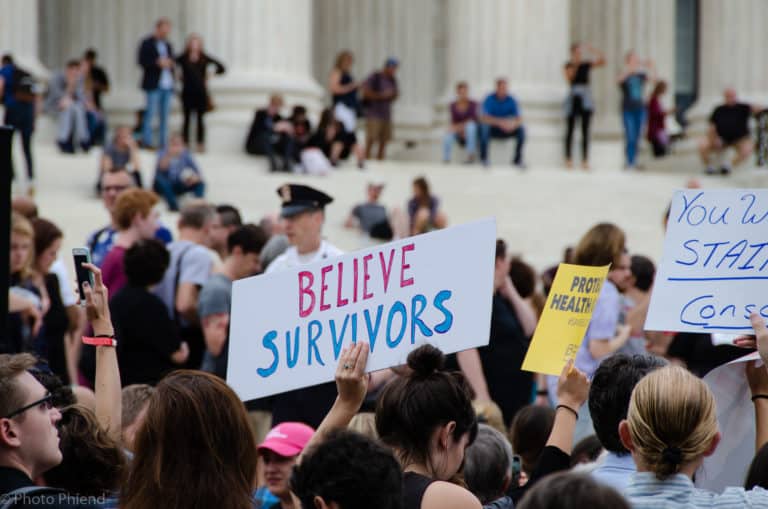Domestic Violence Survivors Need Paid Safe Time Now!

By Preston Van Vliet, State Organizer
Trigger Warning: mentions of domestic violence, mentions of Missing & Murdered Indigenous Women, and safe time
October is End Domestic Violence Month, and indeed the movements to pass and equitably implement paid sick and safe days (PSSD), paid family and medical leave (PFML), and improvements to the child care system help provide significant protections for workers and families who are surviving domestic violence. Remember, there is no federal paid sick and safe day law and no federal paid family and medical leave law. Cities and states have been passing these instead. “Safe days” – which is part of almost all of our country’s paid sick day laws – or “safe time” is time away from work needed to navigate and seek safety from domestic or sexual violence. We know that the same workers who are often excluded from labor protections are also the same workers who are most vulnerable to this type of violence.
Notably, Native communities face the highest and deadliest rates of domestic violence, mostly at the hands of people who are not Native American. This is crucial context given the legal hurdles that Tribal Governments have to prosecute violent non-Native offenders and the woefully inadequate efforts from US governments to do so. This makes Native women and Native queer people all the more vulnerable to violence because of these huge gaps in protection, prevention, and intervention. If you are looking for ways to be a better ally to Native communities, learn about and get involved with the movement for Missing and Murdered Indigenous Women and Relatives (MMIWR).
Did you know that there are a few laws that can provide domestic violence survivors with some amount of their wages if they miss their paid work due to this violence? Let’s talk about crime victim’s compensation, paid sick & safe days, and paid family & medical leave. Historically, crime victim compensation came first. It wasn’t initially about replacing survivors’ wages if they missed work due to experiencing violence, but to provide some restitution for the violent crime and to help them cover medical bills. The first crime victim compensation was in California in 1965. Importantly, it did not prevent victims from being fired if they were employed.
By 1978, 22 states had passed crime victim compensation laws, and the federal Victims of Crime Act (VOCA) law was passed in 1984. Many states now pay victims some of their wages if they miss work due to violence. However, the ‘wage replacement’ rate (aka the percentage of a worker’s usual paycheck that they get while they are on leave) is often not anywhere close to 100% of what a worker’s usual paycheck would have been.
When thinking about any kind of paid leave – including safe time – there are two main components to remember:
- Job protection (so that workers can have their job when they return from leave and they keep their health insurance and other benefits while on leave)
- Wage replacement (the percentage of a worker’s usual paycheck that they get while they are on leave)
Confusingly, job protection and wage replacement have advanced in the US as a series of separate laws, with only relatively recent success and momentum to combine them and to update them together.
So let’s talk about paid sick and safe days. While San Francisco passed the country’s first paid sick days law in 2006, it didn’t include safe time. The 2nd paid sick day law in the country was in DC, in 2008, and that was the first paid sick AND safe day law. From there, almost all of the paid sick day laws also cover safe time. What’s important about paid sick and safe days is that workers get job protection AND get 100% of what their paycheck would have been. The downsides are that it’s only a few days a year and those days do not roll over to another employer if a worker needs to start at a new job. This is where paid family and medical leave helps out.
Paid family and medical leave provides weeks of paid leave. There is a rich history to paid family and medical leave that goes all the way back to 1942 (but that’s for another blog). Regarding safe time within paid family and medical leave, New Jersey’s PFML program was the first to add safe time as a use of leave in 2019. Many survivors need weeks of leave! With these weeks, a worker can go to a shelter, go to court, relocate, and get paid leave while doing all of that. There are a few downsides: in New Jersey, there’s not a lot of job protection, and like many government programs, it can be difficult to understand the eligibility requirements and application processes.
Since 2019, there are now a total of 6 PFML out of the existing 14 paid family and medical leave laws that cover safe time: New Jersey, Connecticut, Oregon, Colorado, Minnesota, and Maine. Each of these states’ programs have their own eligibility and application processes. This is great momentum for survivors that we can continue to build on, especially in making sure that job protection is part of paid leave. If you are passionate about safe time, join us in fighting for Paid Family and Medical Leave in your state and at the federal level!